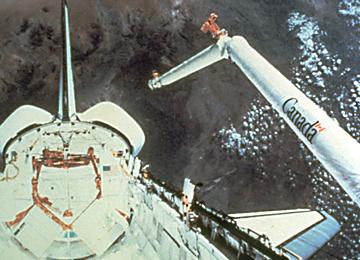
What does canal design have in common with telecommunications and artificial intelligence?

What does canal design have in common with telecommunications and artificial intelligence?
Canada is a wide and varied land. From Nunavut to Nova Scotia, the nation sprawls across vast distances, offering diverse terrain and dispersed population.
That diversity is reflected in the pages of Canada's history books. And while each chapter tells of different challenges to overcome—from the logistical difficulties of canal-based trade in the early 1800s, to the complexities of efficient grain transportation in the 20th century—there's a consistency to the narrative: innovative engineering is always present. It's part of our history, and it is pivotal for our future.
For example, the development of Ottawa's Rideau Canal involved a unique, adaptive construction method for distinctly Canadian conditions. Due to spring and summer floods, water levels could rapidly raise five metres at certain points in the canal.
European techniques were too slow and cumbersome; the dam washed away three times before stone-filled timber cribs were developed. These were robust, quick to build, withstood the volatile Canadian conditions, and ultimately led to improved trade and economic growth.
Another distinctly Canadian innovation? Hundreds of years later, the De Havilland Beaver DHC-2 aircraft proved the sky's the limit for Canadian engineering by first flying in 1947. Thanks to an innovative capacity for short takeoff and landing, and the ability to land and takeoff on water or snow, the DHC-2 Beaver became essential in cargo and passenger hauling, aerial application (crop dusting and aerial topdressing), and other aviation.
When equipped with floats or skis, the DHC-2 Beaver could fly into extremely remote locations and was a crucial aid to social and economic development in Northern Canada.
Today, the achievements of engineers are dotted all over the country: whether in the depths of our canals or the engineers of our aircraft, or in the form of 20th century innovations such as hydroelectric power stations, sky-scrapers, mining and infrastructure for natural resource extraction, telecommunications, or artificial intelligence.
To celebrate 150 years of excellence in Canadian engineering, we consider the profession's exciting past. We asked some of today's luminaries—the recipients of the 2017 Engineers Canada Awards—to share their personal highlights.
What are some of Canada’s most significant engineering achievements in the past 150 years?
Amy M. Bilton, PhD, P.Eng.: The railway which connected Canada from coast to coast, the Canadian National Railway. It was something that united all of the provinces, and was highly influential in terms of the country we became.
Larry E. Seeley, PhD, P.Eng.: In the area of metals—that is, production of nickel—we were the largest producers of metal in the world.
Ross Peters, PhD, FCAE, FEC, P.Eng.: Communications in remote areas, communications in the Arctic. The development of aviation in remote areas is recognised as being a very important technical advancement for Canada.
Jonathan Holzman, PhD, P.Eng.: A lot of the technologies that we now see changing our lives, in terms of communications, have had their start with Canadians and Canadian engineers in particular.
Mary A. Wells, PhD, P.Eng.: We see it around us in the kind of infrastructure we see—the safe infrastructure, the safe drinking water we have. But I'm also very proud of our engineering education system. Our engineers are sought after around the world and offered positions around the world.
Eduardo (Ted) Maulucci, P.Eng.: I think the most inspiring thing to me is what I see academia doing. the shifts that they're making. There are so many things that are happening and so many things that if we can just keep going—and fuel them more—then we're going to see a lot of great things happening with respect to innovation in Canada.
And, what can we look forward to in the next 150 years?
From self-driving cars and space exploration, to the eradication of poverty and storage of solar energy through chemical processes, find out what's in store for Canadian engineering tomorrow, from the perspective of the people leading the profession today.
Eduardo (Ted) Maulucci, P.Eng: The value and importance of engineering is going to be dramatically increasing. Look at all the technology that's coming -- you're going to want to be an engineer.
Amy M. Bilton, PhD, P.Eng.: Clean water, access to electricity, education -- using engineering as a way to make all of those things happen.
Mary A. Wells, PhD, P.Eng.: Water for a planet that is exploding in terms of population. Housing for a planet that is exploding in terms of population. And transportation -- how we transport ourselves in terms of things like the hyperloop and space exploration.
Ross Peters, PhD, FCAE, FEC, P.Eng.: 150 years is a long time in engineering. Things change rapidly. We're going to have challenges, and one of the big ones is adaptation. Engineers are going to be involved In the adaptation that we have in our society.
Veronica Knott: We're going to do great things if engineers stop just building things and start solving problems.


